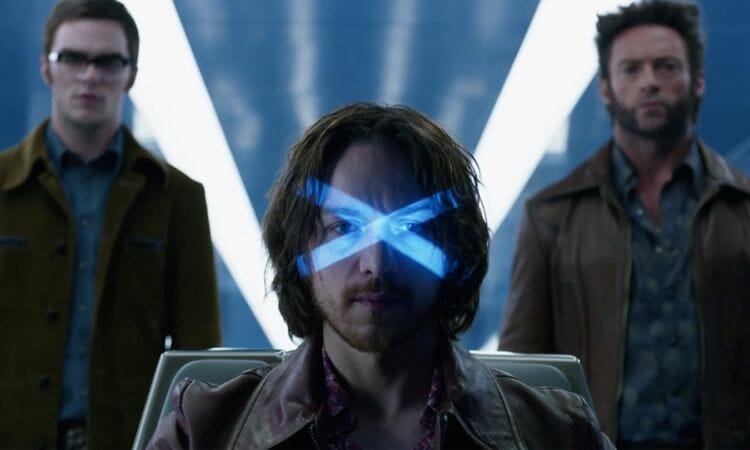By Nguyen Le · May 25, 2014


Welcome to 2023, where mutants and humans suffer under the Sentinels, an invention by Dr. Bolivar Trask. Time to fix that by going back to 1973. With First Class, the X-Men franchise moves forward and welcomes the return of Bryan Singer and company. And the final result is just plain fantastic.
Realizing it takes more than just a hero being hurt, a moody setting or a friend in distress to be a dark superhero film, writer Simon Kinberg (Sherlock Holmes) keeps the pace fast and the tension high, resulting in an omnipresent sense of urgency (and at times, failure) in the film’s two timelines. It helps too that the historical events and figures are appropriately picked, neatly woven with the sci-fi elements and effectively portrayed. Any doubt one may have when news of Vaughn retreating from Days of Future Past break out can be laid to rest.
The same can be said when Bryan Singer is set to replace Vaughn as the film’s director. Maybe returning to one’s roots is as good as introducing a brand-new vision since, besides the references, Days of Future Past’s style is similar to the lauded X1 and X2. Singer makes Vaughn’s cast feel right at home, resulting in me feeling like they’ve been with him since the series’ beginning. Also worth noting is his ability to efficiently handle a lot of characters and create wonderfully paced action sequences, as seen in previous films. Together with Kinberg, Singer successfully persuades me to care for the mutants again like Goldman and Vaughn had done in First Class, fusing the third act with the ability to be emotional.
Of course the cast is crucial in making this happen as well. By now it’s difficult to see someone else other than Hugh Jackman (The Prestige), Sir Patrick Stewart (Star Trek: The Next Generation) and Sir Ian McKellen (The Hobbit) as Wolverine, Professor X and Magneto, respectively. James McAvoy (Narnia 1) and Michael Fassbender (Inglorious Basterds) continue their brilliant acting track record, particularly the former stealing every frame he’s in portraying his character’s loss of purpose. The young (and new) performers do make an impression, some more than others, with limited screen-time, especially Evan Peters (Kick-Ass) as the carefree Quicksilver. Notable mentions go to Peter Dinklage’s (HBO’s Game of Thrones) Trask and Jennifer Lawrence’s (Silver Linings Playbook) Mystique, with both of them managing to convey dedication and determination – one using his diction and the other through her expressions.
(A bit off-topic here: I admire Jennifer Lawrence’s effort in speaking Vietnamese – this is a lethal language to learners but she tries hard. Well done – I could still comprehend a couple of sentences without the subtitles. Still, it’s better than the Martian-esque (?) Brendan Fraser spouts in The Quiet American, doesn’t help too how it happens at and acts as the film’s most crucial moment.)
Nevertheless, despite the new mutants – Blink (Shaolin’s Fan Bingbing), Bishop (The Intouchables’s Omar Sy), Warpath (Twilight’s Booboo Stewart) and Sunspot (FOX’s The Following’s Adan Canto) – are well-introduced – or re-introduced like Storm (Monster’s Ball's Halle Berry, Colossus (Twilight’s Daniel Cudmore) and Shadowcat (Juno’s Ellen Page) – it seems Singer has over-downplayed their powers for this climactic war. It’s made clear that mutants are losing this battle, but by being the remaining few survivors to this day means they must have something to win previous ones. That something isn’t seen here, though on the other hand the Sentinels’ brutality and fearsomeness are highlighted by Singer and the effects team.
It goes without saying that any X-Men film, or any superhero film for that matter, can’t be good if the visuals aren’t up to par. Moving Picture Company and Digital Domain ensure this doesn’t happen, therefore the future looks suitably depressing, the mutants’ powers not to be messed around with and the Sentinels spell doom upon arrival. Of course, Singer’s regular Newton Thomas-Siegel (Drive) provides solid composition and controlled movements to fully showcase the CGI and production designer John Myhre’s (Wanted) work, which comes together in the opening moments, the feud during Paris Peace Accords (retro cameras are nicely used here) and, most beautifully, the jaw-dropping sequence with Quicksilver. I do wish, however, Days of Future Past had gone with film instead of digital because performers’ movements are blurry at certain parts like the majority of Voyage of the Dawn Treader – the sore thumb upon comparison with Disney’s first two spectacular-looking adaptations.
Even with minor quirks, Days of Future Past comes quite close in becoming the perfect superhero movie. It should be a rule by now that you stay for the whole credits when the Marvel logo is seen, and trust me, it’s worth it – definitely a wonderful set-up for X-Men: Apocalypse in 2016. Until then, do yourself a favor: use the present and go see this.